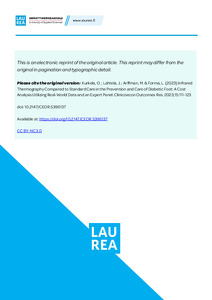Infrared Thermography Compared to Standard Care in the Prevention and Care of Diabetic Foot: A Cost Analysis Utilizing Real-World Data and an Expert Panel
Kurkela, Olli; Lahtela, Jorma; Arffman, Martti; Forma, Leena (2023)
Kurkela, Olli
Lahtela, Jorma
Arffman, Martti
Forma, Leena
Dove Press
2023
Julkaisun pysyvä osoite on
https://urn.fi/URN:NBN:fi-fe2023022728743
https://urn.fi/URN:NBN:fi-fe2023022728743
Tiivistelmä
Aim: Infrared thermography (IRT) is a non-invasive technology for screening and early detection of diabetic foot. Real-world data and the Delphi technique were used to assess IRT’s potential effect on typical care pathways of diabetic foot and their costs in the Finnish healthcare setting.
Methods: The most typical care pathways of diabetic foot were identified from national healthcare registers from 2011 to 2017. The effect of IRT in terms of avoidable care episodes was assessed by a Delphi panel including Finnish diabetic foot specialists (n=13). By combining a series of decision analytic models, the IRT’s potential effect on the costs of each pathway and their sensitivity to model
assumptions were estimated.
Results: Hypothetical annual savings were estimated to be EUR ~1.7 million (EUR ~1.3 million–EUR ~2.5 million), constituting approximately 20% of the total annual care pathway costs examined. In the longer and more complex pathways, the application of IRT was estimated to result in notable savings while in the shorter pathways, IRT could increase costs.
Conclusion: Our modeling suggests that IRT could potentially reduce costs in a Finnish healthcare setting. Given our analysis, generation of robust evidence on the effectiveness of recent IRT technologies with up-to-date protocols seems appropriate.
Methods: The most typical care pathways of diabetic foot were identified from national healthcare registers from 2011 to 2017. The effect of IRT in terms of avoidable care episodes was assessed by a Delphi panel including Finnish diabetic foot specialists (n=13). By combining a series of decision analytic models, the IRT’s potential effect on the costs of each pathway and their sensitivity to model
assumptions were estimated.
Results: Hypothetical annual savings were estimated to be EUR ~1.7 million (EUR ~1.3 million–EUR ~2.5 million), constituting approximately 20% of the total annual care pathway costs examined. In the longer and more complex pathways, the application of IRT was estimated to result in notable savings while in the shorter pathways, IRT could increase costs.
Conclusion: Our modeling suggests that IRT could potentially reduce costs in a Finnish healthcare setting. Given our analysis, generation of robust evidence on the effectiveness of recent IRT technologies with up-to-date protocols seems appropriate.
